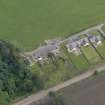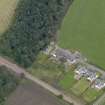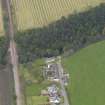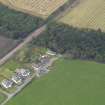Logie, Church
Church (18th Century) - (19th Century), Schoolhouse (18th Century) - (19th Century)
Site Name Logie, Church
Classification Church (18th Century) - (19th Century), Schoolhouse (18th Century) - (19th Century)
Alternative Name(s) United Free Church; Schoolhouse
Canmore ID 196498
Site Number NO66SE 53
NGR NO 69810 63551
Datum OSGB36 - NGR
Permalink http://canmore.org.uk/site/196498
- Council Angus
- Parish Logie Pert
- Former Region Tayside
- Former District Angus
- Former County Angus
Standing Building Recording (1 April 2007 - 31 October 2007)
AOC Archaeology Group were commissioned by the National Trust for Scotland to undertake an historic building recording exercise at Logie Schoolhouse in the small village of Logie near Montrose in Angus. These works were undertaken in April 2007 and were completed to a specification outlined by Mr Robin Turner, Head of Archaeology for the National Trust for Scotland. Logie Schoolhouse is a Category A Listed building and is likely to have been built in the 1830s to educate the children of the nearby workers of Logie Mills to the north and other mills in the surrounding area. Built primarily of clay faced with brick and stone rubble, the building is a rare survival of a clay building in North-East Scotland, specifically for the county of Angus. The study, along with previous historical and cartographic investigations and an on-site condition survey, identified that the building was originally a six- by one-bay single-storey building. The original construction was clay mixed with straw and bonded with pebbles. At some point a hand-made brick facing was applied to the south-east, south-west and north-east sides and a stone rubble facing to the north-west wall. Some of the facing had been replaced on the south-west wall in a slightly newer wire-cut brick dating to the late 19th century. Some small extensions were also originally located on the north-west side, only one of which now survives and is built in red brick with a stone slab roof. The building's original roof was replaced with regular sawn trusses and welsh slates at some point near the turn of the 19th century. At this time the interior also underwent extensive refurbishment with the addition of timber panelling and new lath-and-plaster wall coverings to the main classroom. A timber and corrugated-iron porch was added incrementally to the north-east entrance through the early decades of the 20th century as the building changed use from a Sunday school to a United Free Church.
Diana Sproat, AOC Archaeology Group
Standing Building Recording (August 2007 - November 2007)
NO 698 635 A programme of historic building recording was undertaken between August 2007 and November 2007, on an abandoned clay-built former schoolhouse and church located in the small village of Logie, prior to its renovation and preservation.
Archive to be deposited with RCAHMS.
Funder: National Trust for Scotland.
Diana Sproat, 2007.
Publication Account (2013)
Craigo Mill: flax, later jute spinning mill, founded in c1800. Owned from 1817 by John Maberley, then his successor in 1830, Richards and Co, of Broadford Works, Aberdeen, then passed to J & D Wilkie of Kirriemuir from 1885 so as to ensure that firm’s own jute yarn supplies. The plain between the lade and River North Esk has many drying frames of wire and steel, in order to receive fire damaged jute bales whenever there was a fire in Dundee. Here there was sufficient space to sort the jute, and deal with the spontaneous reignition to which these bales were prone. A large number of timber-framed corrugated iron-clad warehouses is there for the same reason. The mill itself is mainly early 20th century, apart from the older mechanics workshop. Spinning stopped in 1988. The weir on the North Water is by Marykirk Bridge (M10) South east, and utilising the same lade, another early spinning mill, Logie, was founded by Aberdein Gordon and Co (subsequently at Union Street Mill, Montrose, 1837) before 1805, and continued by that firm until 1860. A small mill has been adapted as a house, with an extra storey. The little settlement for workers on the higher ground near the railway line includes Logie School House, NO6980 6353. This clay building was rescued in 2004-8 by the Little Houses Improvement Scheme of the National Trust for Scotland (Europa Nostra Award 2011) and is now rented out.
M Watson, 2013


































